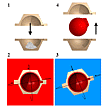
First, the required amount of plastic material is poured into the mould which is then closed. While rotating around two axes the mould is first heated to the melting-point of the plastic and then cooled again.
Finally the mould is opened and the finished part is removed. No finishing operations, like removal of runners, are required. Mainly for small production volumes.
Danish Name
Category
Materials
Typical products
Street bollard
Inspection well
Competing processes
ReferencesDan Hill Plast A/S
Price notes
Photo
Copyright
This page is part of Design inSite
Disclaimer